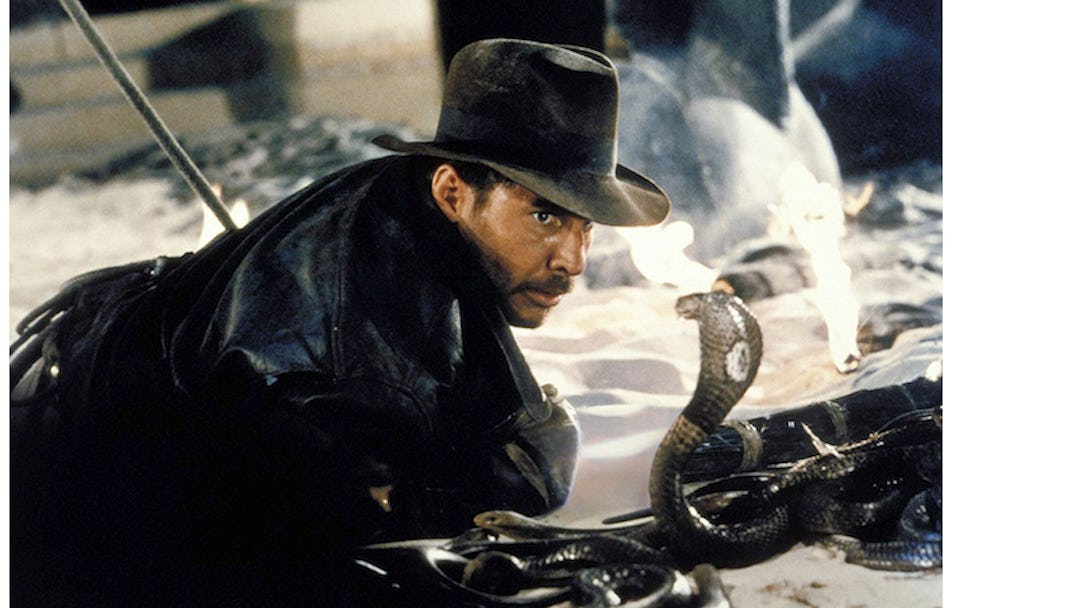When Raiders of the Lost Ark hit theaters 35 years ago this weekend, its carefully prepared origin story became part of movie-going myth: how longtime pals Steven Spielberg (director) and George Lucas (producer, co-story writer) decided to make their first full-on collaboration a tribute to classic Saturday-afternoon cliffhanger serials. They were making an homage to the movies they loved as kids, a noble tradition that continues to this day, with appropriate circularity, to filmmakers who grew up on movies like Raiders. So why do so many of those films feel like imitation, and Raiders felt like something fresh and new?
Part of that origin myth – and seriously, these stories have been told so many times, in so many adoring books and DVD extras and online fan appreciations (like this one, I suppose), that it’s hard to know what’s actually fact anymore – traces the character back to the early 1970s, when George Lucas first drafted the adventures of “Indiana Smith,” around the same time he was figuring out another script inspired by the serials of old, this one centered on one “Luke Starkiller.” He put the former script on hold while pursuing the latter; it didn’t come back to life until Lucas took a trip to Hawaii with Spielberg on the opening weekend of Star Wars and they started kicking around ideas for new projects.
Not that the idea of revisiting classic genres was particularly revolutionary for the period; a key component of the lionized “New Hollywood” era was film brats’ revisionist takes on the gangster movies, private eye pictures, monster flicks, and Westerns they grew up watching. But that wasn’t the business Spielberg and Lucas were in – they weren’t looking to demystify these adventure serials. Their love for them was earnest, free of irony, and their films vibrate with that love (whereas the genre exercises of, say, Robert Altman almost felt like he was punishing them).
Spielberg made no bones about his intentions. “I made it as a B-movie,” he famously said. “I didn’t see the film as anything more than a better made version of the Republic serials.” And that influence is all over the picture, from the overall mood of breathless action to the period specific touches (the loudly squawking birds and dramatic musical stings in the opening jungle scenes; the line moving across the map to signify their flight) to the characterizations of the tough-guy hero and his perpetually game best girl. But there are plenty of other tributes – the iconic opening was inspired by a Scrooge McDuck comic (seriously), the final shot loudly echoes the closing scene of Citizen Kane, and the most beloved single moment (in which an exhausted Indy simply pulls out his gun and shoots an extravagant swordsman) could’ve sat snugly in a Hope and Crosby Road picture.
Yet Spielberg wasn’t kidding about the “better made” portion of that statement, and he’s not just talking about the sophistication of the special effects (though they were certainly impressive, and remain so). Curious moviegoers who sought out the serials Spielberg and Lucas were so enamored with were likely to be disappointed by what that found – quickie throwaways, haphazardly produced, barely written, made for quick consumption and quick discarding. The script Lawrence Kasdan constructed from Lucas and Philip Kaufman’s original treatment (and Lucas and Spielberg’s beach-lounging bull sessions) built a real structure for those breathless set pieces, and populated it with characters that moved far beyond the cardboard cutouts of the originals.
And they were far enough in the rearview that the average moviegoer wasn’t familiar with their specifics anyway – they knew the broad outlines at best. The hidden caves, cobwebs, and booby-traps of Raiders were devices so old they could feel new again, because the window of time since their wide use was so large. The “golden age” of serials ran from the mid-‘30s to the mid-‘40s, ending right around the time Spielberg and Lucas were born; they saw these serials not in their original theatrical runs but as television time-fillers, maintaining a vague recollection rather than any particular specificity.
So when contemporary filmmakers who were raised on Raiders and other films in the Spielberg/Lucas ‘70s/’80s blockbuster canon attempt homage of their own – even in generally good films like Star Wars: The Force Awakens, Super 8 and Midnight Special, or promising efforts like the forthcoming Stranger Things – they’re in a much trickier position. These films are fresher in the collective memory, and more deeply embedded in our cultural subconscious; we know the specific moments, scenes, and ideas they’re referencing, and it’s thus easier to suffer in comparison.
And filmmakers who dwell in homage – not just of Spielberg, but of other ‘80s icons like John Carpenter, David Cronenberg, John Hughes, or Wes Craven – are too often content to stop at faithful quotation, rather than pushing their characters and narratives past tribute and into something fresh and (for lack of a better word) contemporary. This weekend, a new documentary called Raiders! details how three ‘80s kids spent their summers recreating Raiders of the Lost Ark, shot-by-shot, for a homemade VHS fan film. It’s a totally charming, engaging story – and a reminder that professionals have to go just a little bit further with their cinematic valentines.
Raiders of the Lost Ark is streaming on Netflix and available for rental or purchase via all the usual suspects.
